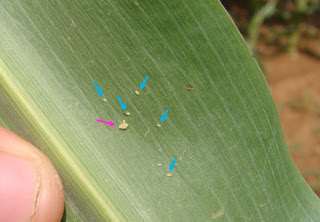By Raul Villanueva
Insect description and damage

The invasive sugarcane aphid (SCA) Melanaphis sacchari has arrived to Kentucky almost a month ahead in 2016 compared to 2015 (https://kentuckypestnews.wordpress.com/2016/02/16/sugarcane-aphid-losses-with-sweet-sorghum/). Sugarcane aphids have caused yield losses going from 30% to
100% to sorghum grower since 2013 on many states of the US. Sugarcane aphids affected severely grain and sweet sorghum fields last year in GA, SC, MO, and TN and KY. Last Friday (7/15/16), a small numbers of sugarcane aphids were detected in a field of sweet sorghum in Trigg County (Fig. 1). Although the numbers are still low in this field, populations may pick up sooner. So far in the U.S all SCA populations are composed by female individuals. Each female can produce 6 to 12 nymphs per day, and in less than one week they can complete its life cycle. This rapid life cycle can cause quick outbreak of SCA populations.
Sugarcane aphids can be identified by their grey to tan yellow body color. Also, their cornicles or “tailpipes”, feet and antennae are dark. Sugarcane aphids feed on the lower surface of the leaves, and their feeding produces yellow to red or brown leaf discoloration which is visible on both sides of the leaf. Indirect damage is caused by the abundant honeydew which may support the growth of black, sooty mold fungus. Honeydew coated leaves can stick to the inner parts of harvest equipment; preventing efficient movement of crop material through the machine and causing choking or damages to combines.
Monitoring and management
To monitor for SCA, walk 20 to 30 feet into the field, select randomly 10 plants walking along 50 feet of a row, check two leaves per plant, one in the bottom (2nd or 3rd leaf from the ground) and one on the top (a leaf under the flag leaf). Tally the numbers of SCA present in each leaf. Repeat this in at least 4 to 5 different sites per field (a total of 80 to 100 plants per field). Take the average of all these leaves. If this average is between 30 to 135 aphids/leaf up to boot stage of development; make an application. Johnson grass is a host of SCA, and the management of this grass should be part of the strategies to control the SCA. The description of the insecticides for the control of SCA in grain and sweet sorghum is described below.
For grain sorghum, growers targeting SCA can apply flupyradifurone (Sivanto Prime ™, Bayer) at a rate of 4 oz./A under a Section 2(ee) label in several states including Kentucky. Flupyradifurone can be applied up to 28 oz/A annually, with a minimum 7-day retreatment interval. Sulfoxaflor (Transform WG™, Dow AgroSciences), is another effective product against SCA. The Environmental Protection Agency (EPA) limits the applications of sulfoxaflor to two per acre per year. A minimum treatment interval prevents applications less than 14 days apart, and no more than 3.0 ounces of sulfoxaflor per acre per year is allowed. I heard this morning that a section 18 exemption will be granted this week by EPA to allow the use of sulfoxaflor in grain sorghum in Kentucky.